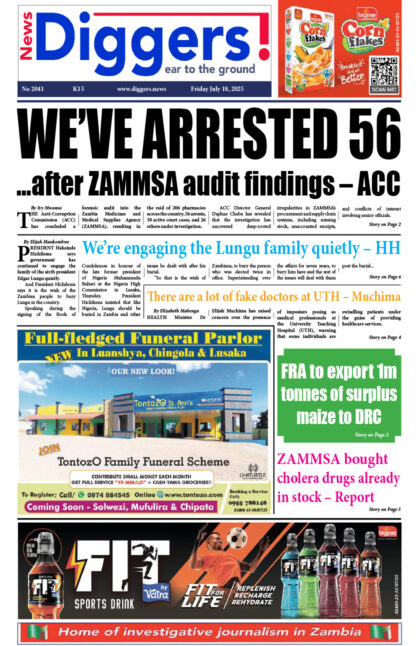RTSA public relations head Fredrick Mubanga says although it is not law for every motorist in Zambia to own a cell phone, motorists are not expected to use that as an excuse for not paying traffic fines when caught by speed cameras which send notifications via SMS.
And Mubanga says RTSA will be putting in place warning signs to notify motorists that “there are speed cameras ahead”.
Meanwhile Mubanga says RTSA’s purpose of putting up speed cameras was not to collect fines, but to change the bad driving attitude and behaviour that has been exhibited as a result of excessive speeding by most motorists.
In an interview with News Diggers! Mubanga said it was a requirement for every motorist to notify RTSA when they changed their contact numbers, so that the new data could be updated in the system.
He however said it was not law for every motorist in Zambia to own a cell phone.
“If you change details as the owner of the vehicle, you have to notify the Road Transport and Safety Agency. That’s a requirement. You just have to update us which new number you are using so that we update what is in the system. It’s not law in Zambia that if you own a vehicle then you have to own a cellphone, its not. [But] If you loose a phone, you have to replace the phone number. And if that old number you have lost is not active, what will happen is that, its a requirement that when you are registering a vehicle, you give your personal details such as the address and the contact numbers. In the absence of contact numbers, the address will be used,” he said.
And Mubanga said speed limits also apply for people driving late in the night.
He urged motorists to follow speed limits at all times.
“Speed limits differ according to localities. In built up areas the speed limits are different. In highways, the speed limits are different. What determines the placement of speed is the frequency of an area that has been identified an accident prone. That’s what will determine the speed at which the road signage is posted. In some areas there are also speed signs that are already posted there so what we are just doing is that members of the public, motorists should follow these speed limits at all times,” he said.
“And in the absence of speed limits, they should follow what the law provides for which is that in built up areas you should move at 40 kilometres per hour, along inter town you should move at 60 kilometres per hour and in highways you should move at 100 kilometres per hour.”
Asked why most speed cameras were hidden instead of being placed in open spaces, Mubanga said warning signs would soon be mounted to notify motorists.
“They are not hidden, if they are hidden then they have to be reset. But going forward, beginning on Monday next week, we will be putting in place warning signs of course to notify members of the public and motorists that these are non speeding zones. For instance if the stretch between Kafue road has got a speed camera, we will put that ‘from this end to this end there’s a speed camera’. Starting from next week this project will be implemented,” he said.
Meanwhile Mubanga said the purpose of putting up speed cameras was not to collect fines but to change the drivers’ attitudes
“The prime purpose of putting these speed cameras is not to collect fines. Its to change the bad driver attitude and behaviour that has been exhibited as the result of excessive speeding on most roads. Especially in Lusaka. So this is a tool that we are using to change the mindset so that motorists adhere to all traffic rules and regulations especially with regards to excessive speed because speeding has been cited as one of the leading causes of road traffic accidents in our country. And if you look at the figures now, from the time we started implementing this project, there has been increased compliance levels in the numbers of motorists, complying to the appropriate speed limits unlike the picture that was there before these cameras were put in place,” said Mubanga.



















